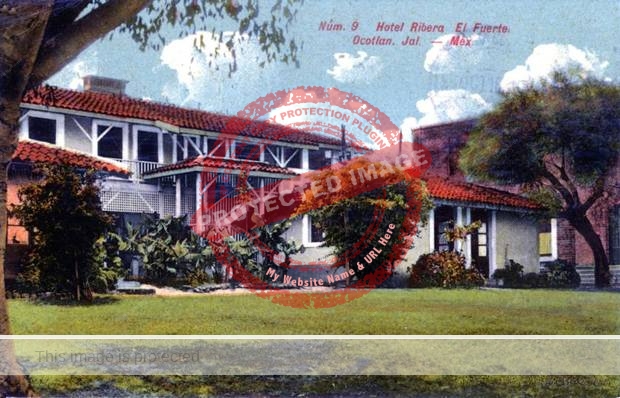This year (2023) marks the centenary of D H Lawrence’s visit to Chapala, where he wrote Quetzalcoatl, the first draft of The Plumed Serpent. At some point in the trip, almost certainly en route to Chapala, Lawrence stayed at the Hotel Ribera Castellanos (located on the lakeshore between Ocotlán and Jamay). This hotel, often called simply Hotel Ribera, no longer exists, but has numerous literary claims to fame dating back to the mid-nineteenth century, when the property was owned by Ignacio Castellanos and his wife, poet Esther Tapia de Castellanos.
In The Plumed Serpent, Ocotlán became Ixtlahuacan (chapter V) and the Hotel Ribera Castellanos the Orilla Hotel (chapters V, VI).
“The hotel consisted of an old low ranch-house with a veranda — and this was the dining-room, lounge, kitchen, and office. Then there was a two-storey new wing, with a smart bathroom between each two bedrooms, and almost up-to-date fittings: very incongruous.
But the new wing was unfinished — had been unfinished for a dozen years and more, the work abandoned when Porfirio Diaz fled. Now it would probably never be finished.” (chapter V)
In the following chapter, Lawrence explained how the “Orilla, which had begun to be a winter paradise for the Americans” had suffered badly during the Revolution but that “In 1921 a feeble new start had been made” and “the hotel was very modestly opened again, with an American manager.” (chapter VI)
That American hotel manager (named Bell in chapter VI) was hotelier-photographer Winfield Scott, who had actually become manager of the Hotel Ribera in 1919. By the time of Lawrence’s visit, Scott had moved on to manage the Hotel Arzapalo in Chapala. When Lawrence and his wife rented a house in Chapala, their traveling companions—Witter Bynner and ‘Spud’ Johnson—took rooms at the Arzapalo. Scott needed little prompting to regale Lawrence and his friends with all kinds of stories of the old days.

Dwight R. Furness. c 1907. Hotel Ribera. (Fig 6-6 of Lake Chapala: A Postcard History)
But when and why was the Hotel Ribera first built? In 1902, American entrepreneur Dwight Furness, who had numerous business interests in Guanajuato, bought the estate from the Castellanos family. Having seen the obvious success of the purpose-built Hotel Arzapalo which opened its doors in Chapala in 1898, Furness envisioned an even grander resort hotel on this lakeside property near the main Mexico City-Guadalajara railroad line, alongside a modern “summer colony” of vacation homes for the wealthy. Plans were announced to add a health spa, golf links and bowling alley. Construction of the first homes and the Hotel Ribera began in 1904. One of the first to build a cottage close to the hotel was Arturo Braniff, from Mexico City, who also bought a much grander house, the Casa Pérez Verdía, in Chapala for his widowed mother.
The Hotel Ribera advertised with the the tagline, “The Riviera of Mexico” and claimed to be a “Sportsman’s Paradise.” It quickly became a highly desirable and popular destination, where all manner of politicians and celebrities would hob-nob over the next decade. Shortly after Furness added 60 more rooms in 1909, journalist Winifred Martin vacationed there; she remarked on the colorful flora and fauna and described the hotel as “picturesque and charming with lawns sloping steeply to the water’s edge… the long rambling building with its tiled roof fits well into the setting.”
When pioneering female travel writer Marie Wright, author of two non-fiction books about Mexico, visited in 1910, she lauded the Ribera as “a fine new hotel of modern equipment.” The following year, Juan Kaiser, the Swiss-born store owner and publisher (responsible for some of the finest early postcards of Chapala and Guadalajara) stayed at the hotel to recover from a relapse of malaria. Not long afterwards, veteran traveler writer Harry Franck arrived by boat from Chapala and stayed a couple of nights, before taking the hotel launch across the lake to La Palma to continue his herculean hike through Mexico.
In February 1911, prolific American children’s writer Emily Huntington Miller (1833-1913), who founded “The Little Corporal”—the first serial magazine for children published in the US—stayed at the Hotel Ribera.
In 1916, Janet M Cummings photographed Lake Chapala for National Geographic. Cummings was one of the first female photographers ever to have work published by that august magazine. She took the image titled “Water carriers at Lake Chapala” in Ocotlán, presumably during a short stay at the Hotel Ribera.
When the Mexican Revolution prompted Dwight Furness and his family to leave Mexico, the Hotel Ribera was sold to Enrique Langenscheidt Schwartz, a prominent German businessman living in Guanajuato. Tragically, his son, Enrique Langenscheidt Jr., was murdered there by bandits in 1919. Despite Scott’s best efforts to revive business, the hotel gradually lost popularity and clientele.
By the time travel writer Edna Mae Stark argued in 1930 that “The most modern town on the shores of Lake Chapala is Ribera Castellanos, which is destined for popularity as a vacation resort. With a good hotel as headquarters, guests may fish, or hunt, swim or ride horseback, go motoring or sailing,” the hotel was in terminal decline. All that remains today of this once-grand lakeside resort are a few ruined walls.
See chapter 6 of Lake Chapala: a postcard history for an extended history of the Hotel Ribera Castellanos.
Comments, corrections or additional material related to any of the writers and artists featured in our series of mini-bios are welcomed. Please use the comments feature at the bottom of individual posts, or email us.
Tony Burton’s books include “Lake Chapala: A Postcard History” (2022), “Foreign Footprints in Ajijic” (2022), “If Walls Could Talk: Chapala’s historic buildings and their former occupants” (2020), (available in translation as “Si Las Paredes Hablaran”), “Mexican Kaleidoscope” (2016), and “Lake Chapala Through the Ages” (2008).
what a beautiful hotel and interesting history
Thanks, Bill. Warm regards, Tony